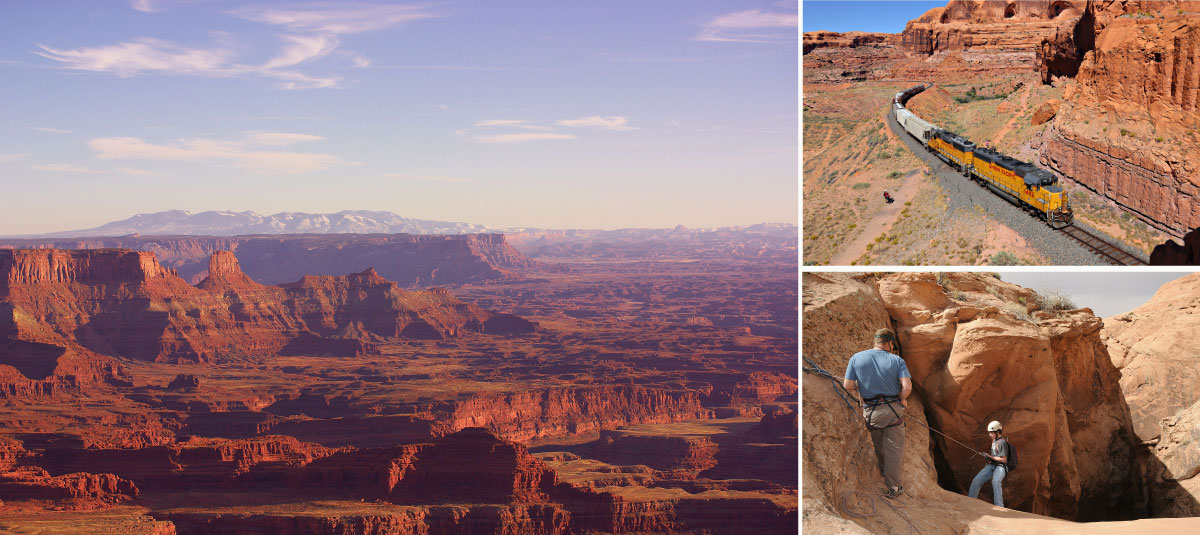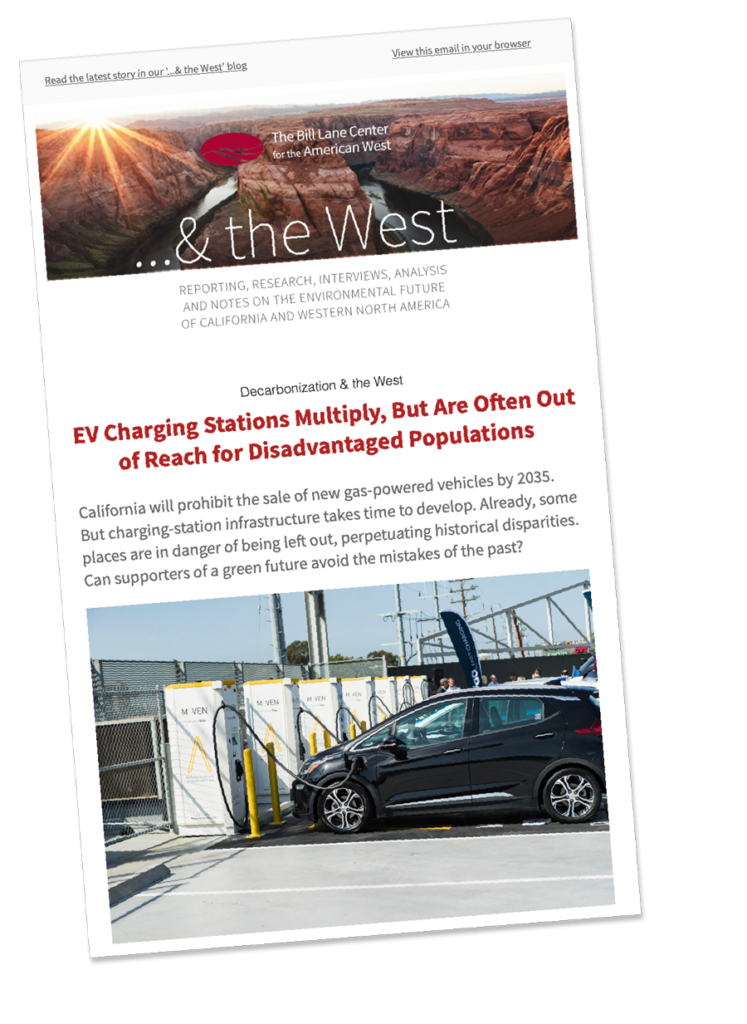Endless Attractions Beyond the otherworldly landscapes of the national parks at Arches and Canyonlands, the public lands around Moab in southeastern Utah contain spectacular vistas like those visible from Dead Horse Point State Park above the Colorado River, left. Extractive industries, embodied by the “Potash Local” train taking minerals to market, upper right, also are part of the region. Lower right, canyoneers outside of Moab. Clockwise from left: Nick Gilbert via Flickr; Jerry Huddleston via Flickr; Tom Kelly via Flickr
Flinging down the gauntlet to environmental groups in the Southwest nine years ago, the outgoing Bush administration leased 77 tracts of public land across eastern Utah for oil and gas extraction. Many of those leases followed the curve of the Green River as it ran down the length of the state. Others clustered in patches at the edges of Arches and Canyonlands National Parks, and Dinosaur National Monument.

The old 2009 leases Oil gas leasing areas (in red) near Arches and Canyonlands National Parks (green) were opened to development by the Bush administration in its final days. They were quickly cancelled by the Obama administration. Some of those areas are now back in play. Skytruth and Google via Flickr
The leases were eventually canceled by the Bureau of Land Management after a barrage of lawsuits resulted in federal court rulings that the leasing process had disregarded federal law.
Avoiding similar confrontation with environmentalists became a priority for the incoming Obama administration, which developed an advance planning process, a forum for compromises on the future of heavily contested public lands. “If you knew that the area was one that had potential for resource conflicts that were fairly significant, and it had potential for development,” explained one Obama-era BLM official, speaking on condition of anonymity in order to avoid conflict with clients, “why not get out in front of it?”
So were born Master Leasing Plans, or MLPs, developed to supplement standard land-use planning in areas where fragile environments, popular outdoor recreation, or valuable cultural artifacts overlapped with drilling interest. Over the years, eight MLPs were finalized across three western states. They cover lands that border national parks and monuments, contain popular hunting and fishing grounds, or shelter cultural artifacts.

The Moab Master Leasing Plan area in southwestern Utah, which arose from an abortive plan to offer 77 oil and gas sites for leasing.
Oil and Gas Industry Resistance
The oil and gas industry pushed back against the process. In response to industry complaints, the Trump administration has moved quickly to set the program aside, freezing progress on proposed plans and restarting leasing in contested areas. A decade after the cancelled lease sale, the same conflicts drag on over many of the same tracts of public land.
To industry, the process was redundant, given the environmental reviews already required for leasing on federal lands. Kathleen Sgamma, president of the Western Energy Alliance, an industry trade group, said that adding further layers of review for conflict-prone lands would only provide “more opportunities for litigation.”
Asked whether the eight finalized Master Leasing Plans had ever directly inhibited drilling interests, Ms. Sgamma mostly demurred, explaining that the industry’s objections were “a process concern” focused on preventing time-consuming duplicative environmental reviews and keeping unprotected public lands open for leasing. “We have plenty of lands that are already off limits,” she said. “I don’t see a need for any more.”
She also dismissed the program’s relatively narrow focus on conflict-prone areas. “There’s not a single piece of public land out there that doesn’t have usage conflicts,” she explained. “No matter how much analysis BLM does, they’re always going to get sued.” With environmental groups, “it’s never enough.”
Forestalling Litigation
Obama administration officials believed that the new process could keep many cases out of court. By assessing contested lands before leasing fights began, the BLM had a chance to forge consensus among litigious stakeholders, who could agree to protect some areas for conservation while selecting others for leasing. To the ex-official, who helped design the program, this was “resource development in a thoughtful, comprehensive way, and carving out a path for development that would be more efficient, ultimately.”
Environmental lawyers agree. Mike Freeman, a staff lawyer for EarthJustice, an environmental nonprofit, says that the leasing plan system and associated reforms had a significant impact on leasing conflict. “If they strike a reasonable balance, they’re a lot less likely to be sued. There’s always going to be some conflict, but this goes a long way towards reducing it,” he said.
Environmental groups believe the numbers support their good-faith efforts to compromise. “The number of lease challenges dropped significantly” after BLM implemented the program, said Mr. Freeman. After the Obama administration reforms, the rate of leases protests dropped by more than half.
Post-leasing lawsuits are expensive, risky and often ineffective for achieving landscape-scale conservation. “I don’t think it’s in the interest of any party, to go back into that mindset,” said David Nimkin, senior regional director for the Southwest at the National Parks Conservation Association, “when in fact you can put in a bit of elbow grease into planning first and identifying areas of common agreement where development can occur.”
A Mosaic of Competing Uses
Proposed by the Obama administration in 2009 and recently cancelled by the Trump administration, Master Leasing Plans were intended to identify and resolve conflicts among competing resource needs on public lands run by the Bureau of Land Management. In areas where mineral and energy extraction interests might impinge on recreational, archeological, or conservation uses, Master Leasing Plans sought to balance those interests – with “no presumed preference for oil and gas development over other uses.”
The Moab Area Master Leasing Plan was the first MLP to be implemented in 2016. The region, just outside Southeastern Utah’s tourist mecca, occupies the margins of Arches and Canyonlands National Parks, and is bisected by the Colorado River. Over the years, it has been the site of gas, oil, and potash extraction; has been cited for archeological finds; is popular with hikers and canyoneers; and has served as a location for numerous Hollywood films, from Comancheros (1961) to the Greatest Story Ever Told (1963),Thema and Louise (1990), and Mission: Impossible II (1999), among others.
Move over or tap the items in the list to filter the maps.
Selected Zones in Moab Master Leasing Plan





- Hover Text to Filter
- All Uses
- Extractive Uses
- Conservation Uses
- Recreational Uses
- Cultural Uses
Conservation Uses






- Water Resources
- Sensitive Plant Habitat
- Mexican Spotted Owl Critical Habitat
- Pronghorn Fawning Habitat
- Desert Bighorn Sheep Herd
Cultural Uses





- Cultural Sites
- Potential Sites
- High-Use Filming Locations
- Old Spanish National Hist. Trail
Recreational Uses





- High-Use Routes and Trails
- High-Use Climbing and Canyoning
- Visual Resource Management (Class II)
- Scenic Backways and Byways
Extractive Uses






- Oil and Gas Leasing
- Cancelled Leases (2009)
- Potash Leasing Areas
- Potash Processing Facility Areas
2017 Brings Large Lease Sales
The change in administrations has brought oil and gas leasing back to areas once proposed for MLP status. During the second half of last year, large lease sales took place at regular intervals across the Southwest, despite what some industry experts characterize as an oversupplied oil and gas market. On December 12, a lease sale in Utah’s Green River district offered 74 parcels, more than a 300% increase over last December’s lease sale in the same district. Oil prices have strengthened since cratering in 2014, said Ian Lange, an assistant professor of economics and business at the Colorado School of Mines.
The fight over master leasing plans has touched only one corner of the American oil and gas leasing landscape. Finalized plans cover some 3.27 million acres –just over half a percent of all federal lands. Another 2.89 million acres had been proposed as master leasing plan areas by the end of the Obama administration. By comparison, oil and gas leasing currently occupies some 27.2 million acres of public land.
Finalized Master Leasing Plan Areas

Eight Master Leasing Plan areas, above, were approved by the BLM between 2014 and 2015. Seven more in these three states were under preparation by the BLM. Geoff McGhee
Conflict areas “get a lot of attention, but they’re a very small minority of the overall leasing that’s going on,” said Mr. Freeman. To Dr. Lange, industry’s strident objections are, in effect, “slippery slope arguments” that reflect concern about the possibility of more substantial leasing restrictions, not the direct impacts now.
Derrick Henry, a national spokesperson for the BLM, said in a prepared statement that “the goal of the BLM’s land-use planning efforts remains the same as always, which is to be a good neighbor with the communities we serve.” Officials now involved in leasing and land management at the state and national levels declined to comment for this story or did not return calls.
The shift in priorities is clear to the former BLM official. “A lot of what they’re proposing to do….really shuts the conservation community out of the process.” When people “can’t influence the process, one of their major other tools they have is suing,” the official said.

Back Open for Business? A promotional billboard outside Moab in 1972. Boyd Norton, U.S. EPA via U.S. National Archives
Many of the 77 lease tracts which originally prompted the reforms are now protected as part of the Moab Master Leasing Plan. “Those are lands that had been fought about for years, were the subject of lawsuits, and were not going to stop being a source of conflict for that community,” explained Nada Culver, a senior counsel at The Wilderness Society. Now most of the region between Arches and Canyonlands National Parks is off-limits to leasing, while tracts further from park boundaries are available for oil, gas, and potash production. Of Utah’s five proposed MLPs, only Moab’s has been finalized.
On the Horizon: Increased Resource Conflicts
With both sides anticipating increased conflict, conservation groups see a return to the conditions that precipitated the long legal fight over the Bush administration’s final leases. Ms. Culver predicted this would be detrimental to the oil and gas industry in the long run. Indiscriminate leasing “ended up slowing down leasing and development” because it prompted lawsuits and lengthy rewrites of government decisions. “Everything started coming to a halt, whether it was justified leasing or it wasn’t.”
Industry, conservation groups, and the BLM all say they want the same thing: “a more stable, certain process,” in Ms. Sgamma’s words. But compromise remains elusive. For industry, a stable process means reliable approval of their applications on a lease-by-lease basis. For conservation groups, it means landscape-level advance planning that excludes drilling in the most contentious areas, while expediting it in others.
In the short term, Ms. Sgamma sees the halt in new planning processes as a victory for rational energy development. To Ms. Culver, though, the BLM is merely dodging the problem: “These are conflicts that have been going on for a long time, and they’re not going to go away just because you take away the tool that was created to try to address them.” And so, Freeman said, “it’s inevitable that we’re going to be seeing more of them in court.”
Read Next in ...& the West
Tracking Proposed National Monument Reductions in the West
New details have emerged about Interior Secretary Ryan Zinke's proposal to modify national monuments designated since 1996.
Reader Comments
Submit your own thoughts and questions by using the form at the bottom of this page. Entries will be reviewed and posted as we get them.



























